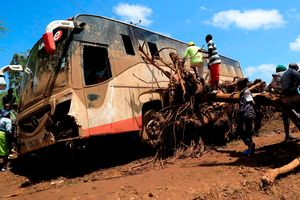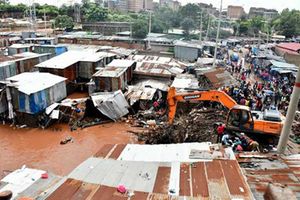
A bus marooned by floodwater at Kware area in Pipeline, Nairobi after heavy rains on May 1, 2024. (Inset) Nairobi Governor Johnson Sakaja.
The Green City in the Sun is now underwater with the rains pounding the country exposing the capital’s under-belly. The raging floods have left a trail of death, filth, submerged houses, and impassable roads.
Despite its unrivaled infrastructure in the region, the downpour has exposed the deficiencies of urban planning in Nairobi, aggravated by the endemic construction of commercial and residential buildings on riparian land.
As rains continue to wreak havoc, evidence of the city’s poor drainage system is everywhere you go.
Storm water and flash floods have turned roads into overflowing rivers and swamped homes leaving a trail of destruction and bedlam with the city bearing the brunt of the brute force of nature.
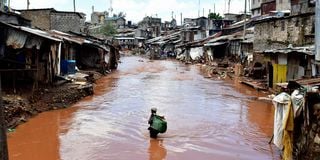
A flooded Mathare River as it passes through Mathare Slums Gitathuru area on April 27, 2024.
From the shacks in the city’s informal settlements to the genteel mansions of up-scale neighbourhoods, the impaired drainage system is a case study in the dysfunction at City Hall. At least 12 bodies have been retrieved from Mathare River after they were swept away by floods. A number of people have also been reported missing.
Several residents have been displaced with many homes left marooned while transportation networks in various parts of the city disrupted with some roads rendered impassable. Kenya Railways was forced to announce temporary suspension of commuter train services over safety issues, while the Kenya Urban Roads Authority also announced partial closure of four roads in the capital.
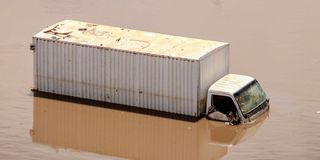
A lorry marooned by floodwater at Kware area in Pipeline, Nairobi after heavy rains on May 1, 2024.
The CBD, which hosts many government offices and Parliament, isn’t doing any better. Bearing the worst brunt of poor drainage system and urban planning have been informal settlements which have recorded most of the reported deaths. Mukuru kwa Njenga, Fuata Nyayo, Land Mawe, Mukuru Kayaba, Mathare, Njiru, Ruai, Utawala, Kibra and Mukuru Kwa Ruben have stories to tell.
But the current situation will not be a one-off. When it rains in Nairobi, flash floods have been a constant fixture. The problem has been blamed on outdated designs and continuous dumping of solid waste in drainage systems. When former Governor Mike Sonko assumed office in 2017, he accused his predecessor, Dr Evans Kidero, of squandering funds meant for rehabilitating drainage systems.
But he fared no better with his administration also spending millions to address the problem with no tangible results. In March 2018, City Hall, together with the Directorate of Urban and Nairobi Metropolitan Development, set aside Sh194 million to address the flooding menace in Nairobi.
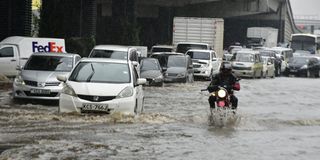
Motorists drive through a flooded section of Mombasa Road between Bellevue and Nexgen Mall in Nairobi on January 13, 2024
Sh32 million was to be used to improve the drainage system and put up measures to mitigate the effects of the heavy rains. The results of money not well-spent are now manifesting. The blockage of waterways during construction has often led to flood water being directed to estates with informal settlements having to pay the biggest price due to its lack of drainage system coupled with haphazardly developed structures. The existing drainage system, which is meant to direct stormwater into rivers, is mostly clogged by solid and domestic waste defeating its purpose.
The city is heaving under heavy pressure from filth caused by indiscriminate disposal of solid waste and a failure by City Hall to collect most waste generated by the residents. Dumping of waste, which blocks the storm drains, is one of the major causes of flooding in the city. With rivers in the city choking on garbage, wastewater from industries and raw sewage, residents, especially those living in the informal settlements, have been left exposed to serious waterborne illnesses as sewer mixes with storm water from open drains.
Many urban planning experts attribute the chaos to the lack of proper drainage infrastructure, developments along riparian reserves, and newly built up areas that block natural water flows.
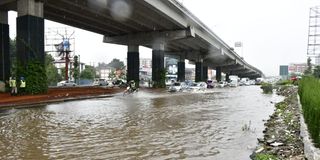
A flooded section of Mombasa Road between Bellevue and Nexgen Mall on January 13, 2024.
Others contend that the drainage system installed in the 1920s has barely been upgraded to match both the planned and unplanned developments wrought on the city over the years. According to City Hall records, the city’s drainage was originally designed to serve less than 500,000 people, a population that has since ballooned to more than five million. But even with the changing face of the city, successive administrations have ignored the improper property developments that have continued to block waterways compounding the flooding problem. Mr Mairura Omwenga, chairman of the Town and County Planners Association of Kenya (TCPAK), recently said: “As the city grows, much of the open ground gets covered by buildings, roads, leaving less open area for rainwater, which causes surface runoff and thus more likelihood of floods.”
He emphasised the need for investment in comprehensive drainage systems, maintenance and expansion. Prof Lawrence Esho, a spatial planner, calls for a drainage masterplan to cover the entire metropolitan area. He says the issue is bigger than just the illegal buildings but also uphill destruction of land, too much concrete pavements aggregating the run off flow, blocked drains and climate change.
“Over the last 20 to 25 years the city has also gone through the change from bungalows built over a huge area to high-rise apartment blocks without a drainage city master plan change,” he explains.
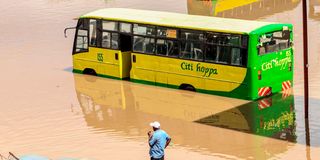
A man watches a bus marooned by floodwater at Kware area in Pipeline, Nairobi after heavy rains on May 1, 2024.
He advises builders to leave gaps between pavements for grass to allow the water sip under when it rains. Mr Pius Masai, a safety, security and disaster risk management expert, says constructions done on water paths are to be blamed.
He argues that it is important for the county government to check the exit of the stormwater. “With- out knowledge of the end product, opening the roads, terraces, and drainage won’t be a solution. And the collected stormwater with no exit will cause damage and death,” he says. The experts have called for the revamping and improvement of the drainage system to accommodate the growing population, enforcement of building regulations, ensuring proper garbage disposal to address the perennial problem. They contend that physical developments need supporting infrastructure such as roads and drains, while saying there is need for careful urban planning and construction. Even as the city continues to record deaths, displacement and loss of property, a lack of preparedness by the county government has been exposed despite billions received annually.
Nairobi County receives at least Sh19.5 billion annually from the national government as equitable revenue share while it also collects an average of Sh10 billion (if what City Hall declares is anything to go by) as own-source revenue for a combined fund basket of Sh29.5 billion every year.
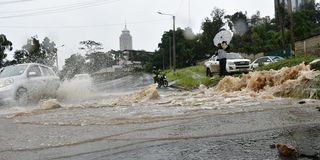
Motorists drive through a flooded section of Lower Hill Road at the junction of Haile Sellasie Avenue as heavy rains hit the city.
However, every year, the county has always been caught pants down by floods during heavy rains seasons despite warnings by the Kenya Meteorological Department. In September last year, Mr Sakaja said his ad-ministration will hire 3,500 youth to be tasked with daily cleaning is the city, unclogging and cleaning of drainages and garbage collection, among other activities. He pointed out that the timely unclogging of the drainage systems will allow steady flow of water to avoid blockages and lower risks of flooding.
Further, the county’s Environment department had also mapped out disaster hotspots prone to flooding and deployed a team to unclog the blocked drainages as part of plans to avert the hazardous impacts likely to be posted by the above-average rain.
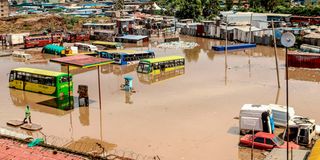
Buses stuck in floodwater at Kware area in Pipeline, Nairobi on May 1, 2024.
“We have mapped out disaster hotspots and deployed green Nairobi team to unclog blocked drainages,” said Mr Sakaja. He also ordered demolition of illegal structures established along riparian lands and drainage trenches as mitigation measures to aid in combating the El Nino risks. “All illegal structures put up along drain ages are going to be demolished,” he said. City Hall was even toying with purchasing motor boats, inflatable water rafts, and boats to mitigate potential flood-related crises. Two months later, Sakaja announced how intervention works, including outfall drain cleaning and lining, unclogging of blocked drains, de-siltation and repair of drains, and improving drainage channels’ capacity to suitable discharge points, averted any flooding menace. But five months later, the much-publicised interventions have just been on paper.
Despite Ruai, Mathare and Kibera identified by the county government among 436 flood hot spots, many of the recorded deaths are from there. With the death toll increasing, Mr Sakaja last week came back with the same story of a multi-agency disaster management team mapping out areas adversely affected by the floods.
He further announced that private service providers ensure all waste collected is taken to Dandora dumpsite, suspension of all excavations along riparian areas and immediate relocation of inhabitants along riverbeds to high areas, among other raft of measures.
“All building development approvals have been halted for now until we can review all those that have been issued and are continuing in the city,” he said.
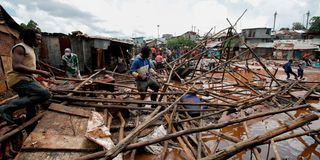
Residents sift through the rubble as they recover their belongings after the Nairobi River burst its banks and destroyed their homes within the Mathare valley in Nairobi, Kenya April 24, 2024.
This was a climb-down from an earlier statement last month when the governor said building of highrise apartments, even up to 75 floors in some areas, will continue despite haphazard urban planning and construction being blamed for putting a strain on the city’s drainage network. “The capital is taking an inevitable expanding trajectory and more room to accommodate more Kenyans must be created. 25 floors were area-specific (around the airbase) and not a blanket restriction. We have proposed an area-specific zoning framework that goes up to 75 floors in some areas. It is before the assembly,” he said then. Sylvester Kasuku, an urban planner with a bias on infrastructure, planning development and policy advisory, says Nairobi’s problem is both historical and contemporary. He says that the Nairobi of early 1990s is not the one we currently have. The city has undergone massive development. Heavers Nairobi has had several development plans with the first plan in 1905 to make it a railway town.
Then came the settler master plan in 1927 for a colonial capital.
Mr Kasuku opines that the plans had mistakes as there was a need for having an integrated plan for both land use, transportation infrastructure and services required of a city. “There was much more emphasis on land use development without proper development controls,” says Mr Kasuku.
Then came the 1973 master-plan which tried to address the gaps but its implementation was not properly done. “Remember that even developments like the bypasses were supposed to be developed much earlier than they were developed and used. Those were developments were to have been done in the 1970s and 1990s,” he says.
Mr Kasuku argues that in the case of Nairobi, there was need to make sure infrastructural services and facilities that are required to support the city were provided. “There was a need for having an integrated planning for both land use, transportation infrastructure and services that is required of the city. There was much more emphasis on land use development without proper development control. The city is therefore not resilient as we speak whenever it rains,” he adds.


